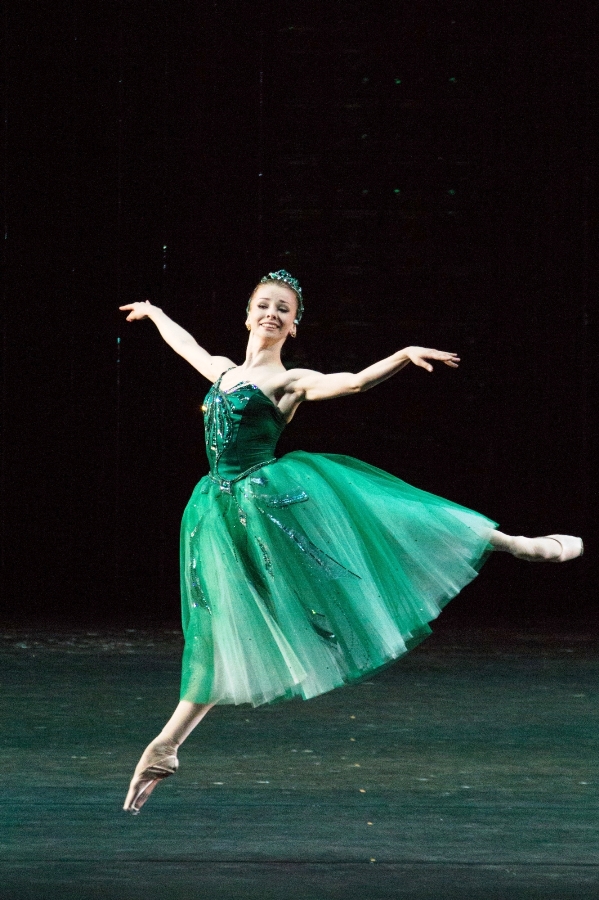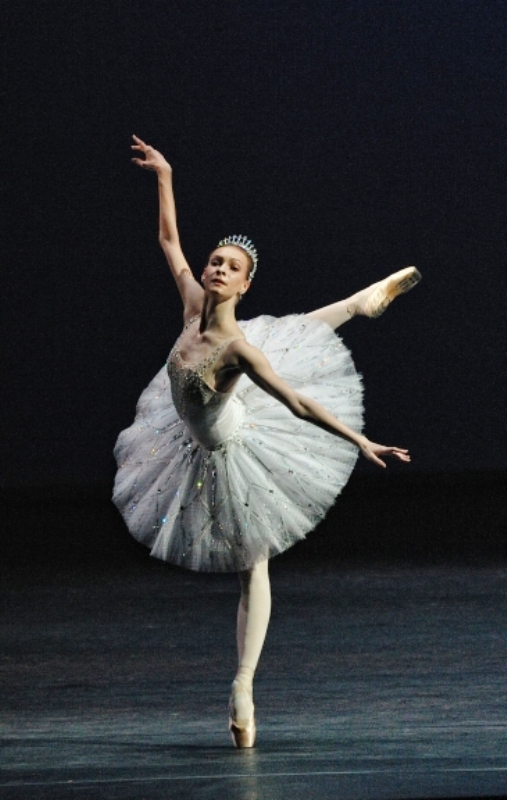The Bolshoi’s summer season in London has so far been straight-down-the-line trad: Swan Lake as an opener, Bayadère, Sleeping Beauty. Now, however, with Balanchine’s Jewels, they’ve at least dipped a pointe shoe into the 20th century, if rather cautiously.
Jewels is, to be blunt, a beast of a ballet to get right – or, to change metaphor, it is a will o’ the wisp, ambiguous in style, constantly shape-shifting before our eyes. To get to grips with it, from either side of the footlights, is not simple, and neither the company (who acquired this work only last year) nor the audience was entirely certain of its responses.
 It is a three-act abstract ballet, and a three-act history of dance lesson. Each movement, represented by a jewel, encapsulates a dance style and period. Emeralds, to extracts from Fauré’s Pelléas et Mélisande and Shylock, represents the Romantic movement; Rubies, to Stravinsky’s Capriccio for Piano and Orchestra, neo-classicism; and Diamonds to Tchaikovsky’s Symphony No 3 (minus the first movement) the high classical style.
It is a three-act abstract ballet, and a three-act history of dance lesson. Each movement, represented by a jewel, encapsulates a dance style and period. Emeralds, to extracts from Fauré’s Pelléas et Mélisande and Shylock, represents the Romantic movement; Rubies, to Stravinsky’s Capriccio for Piano and Orchestra, neo-classicism; and Diamonds to Tchaikovsky’s Symphony No 3 (minus the first movement) the high classical style.
Emeralds is the most difficult of the three sections, a gossamer construct of music and mood that disintegrates at the slightest rough handling. And it got a fair amount of that. Evgenia Obraztsova (pictured right), one of their loveliest dancers, danced with restraint and a certain charm, but never found her way into the heart of the style, while Anna Tikhomirova’s dead upper body and flat arms were matched by ears that were seemingly deaf to the music coming out of the pit.
It was left to Ana Turazashvili in the trio to show what could be done. Resembling nothing so much as a Modigliani come to life, Turazashvili floated and drifted, her neck and shoulders always in the correct Romantic shape, even as they were always moving forward, pulsing with Fauré’s phrasing.
Rubies, by contrast, should be bright and brassy and bold, and Ekaterina Krysanova (main picture, above), scampering nimbly through her fiendish solos, her astonishing loose hips allowing her to kick off dazzling développés, did her best to make it just that. Both she and her partner, the careful Dmitri Gudanov, started slowly, but suddenly seemed to realize that if they had fun, we might too; and we did.
Overall, the Bolshoi (like the Royal in this same piece) can’t quite get down and dirty enough – they’re slumming, rather than inhabitants of Stravinsky and Balanchine’s dive. “We’re having fun,” they seem to be saying, “but don’t tell mother.”
Stylistically, altogether the company is a bit lacklustre at the moment. There are too many awkwardly held heads and too many necks pushed down into shoulders when a difficult step approaches, while the men’s arms en couronne look as though someone shouted "stick ’em up!"
 The highlight of the evening was, theoretically, the Bolshoi’s new star, Olga Smirnova (pictured left), who has been dazzling audiences all season, in the final movement, Diamonds. I hadn’t seen Smirnova since she appeared in London a couple of years ago, still a student. She was promising then, triumphant now. But – a big but – Diamonds doesn’t call for triumphalism.
The highlight of the evening was, theoretically, the Bolshoi’s new star, Olga Smirnova (pictured left), who has been dazzling audiences all season, in the final movement, Diamonds. I hadn’t seen Smirnova since she appeared in London a couple of years ago, still a student. She was promising then, triumphant now. But – a big but – Diamonds doesn’t call for triumphalism.
It is perhaps unfair to list the roll-call of greats who have dazzled in Diamonds – Lopatkina, a shining mystery; Farrell, an Amazonian huntress; Cojocaru, a flickering Aurora. Alyona Pikalova's sets remind us that Diamonds is separated from the other two Jewels, which have ballroom surrounds, while Diamonds opens on a night sky. It is mystery and awe that Balanchine hears in Tchaikovsky, and that is explored by the greatest interpreters.
Smirnova is grand rather than mysterious. And her decision to go for a hard, flat brilliance leaves no space for the final most delicate moment in the piece, the supported promenade on pointe, when the ballerina reaches, finally, outwardly to – what? That undiscovered country from whose bourne no traveller returns: death.
In Smirnova’s interpretation, all I could see was courtly demeanour. Her dancing was brilliant and dazzling and amazing. And it was, for me, all wrong.
By far the most moving moment of the evening was not danced at all. With the final curtain calls, Sergei Filin, the company’s artistic director, who was blinded in an acid attack eight months ago and has been having treatment to try and save some small remnant of his sight ever since, appeared on stage. His low bow to the company, many of whom have indicated support for a dancer who may have been involved in the attack, was heartbreakingly generous.
Overleaf: watch Suzanne Farrell and Peter Martins in Jewels














Add comment